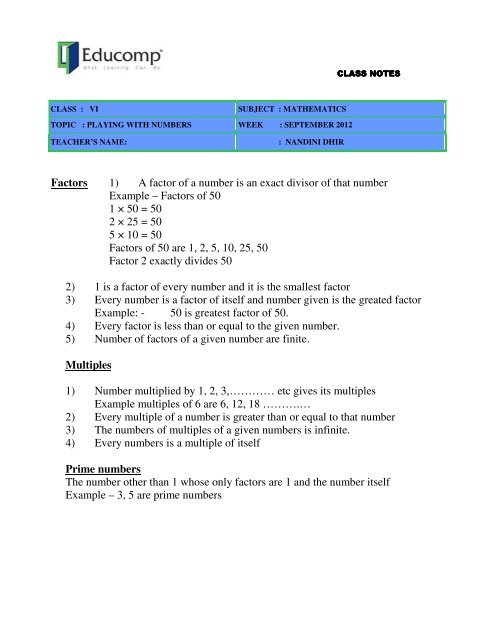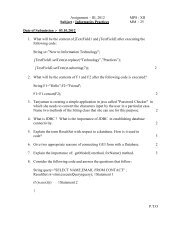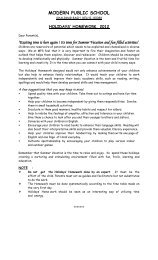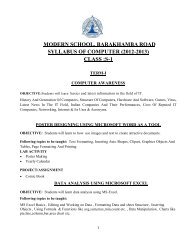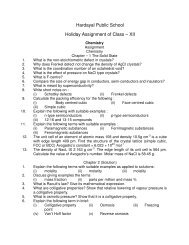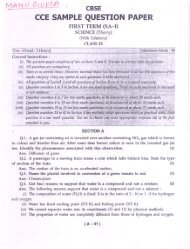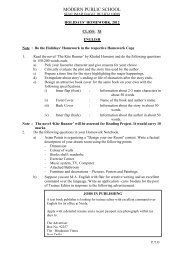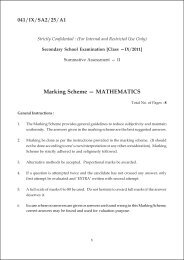Factors 1) A factor of a number is an exact divisor ... - Educomp Online
Factors 1) A factor of a number is an exact divisor ... - Educomp Online
Factors 1) A factor of a number is an exact divisor ... - Educomp Online
You also want an ePaper? Increase the reach of your titles
YUMPU automatically turns print PDFs into web optimized ePapers that Google loves.
CLASS NOTES<br />
CLASS : VI<br />
SUBJECT : MATHEMATICS<br />
TOPIC : PLAYING WITH NUMBERS WEEK : SEPTEMBER 2012<br />
TEACHER’S NAME:<br />
: NANDINI DHIR<br />
<strong>Factors</strong> 1) A <strong>factor</strong> <strong>of</strong> a <strong>number</strong> <strong>is</strong> <strong>an</strong> <strong>exact</strong> div<strong>is</strong>or <strong>of</strong> that <strong>number</strong><br />
Example – <strong>Factors</strong> <strong>of</strong> 50<br />
1 × 50 = 50<br />
2 × 25 = 50<br />
5 × 10 = 50<br />
<strong>Factors</strong> <strong>of</strong> 50 are 1, 2, 5, 10, 25, 50<br />
Factor 2 <strong>exact</strong>ly divides 50<br />
2) 1 <strong>is</strong> a <strong>factor</strong> <strong>of</strong> every <strong>number</strong> <strong>an</strong>d it <strong>is</strong> the smallest <strong>factor</strong><br />
3) Every <strong>number</strong> <strong>is</strong> a <strong>factor</strong> <strong>of</strong> itself <strong>an</strong>d <strong>number</strong> given <strong>is</strong> the greated <strong>factor</strong><br />
Example: - 50 <strong>is</strong> greatest <strong>factor</strong> <strong>of</strong> 50.<br />
4) Every <strong>factor</strong> <strong>is</strong> less th<strong>an</strong> or equal to the given <strong>number</strong>.<br />
5) Number <strong>of</strong> <strong>factor</strong>s <strong>of</strong> a given <strong>number</strong> are finite.<br />
Multiples<br />
1) Number multiplied by 1, 2, 3,………… etc gives its multiples<br />
Example multiples <strong>of</strong> 6 are 6, 12, 18 ……….…<br />
2) Every multiple <strong>of</strong> a <strong>number</strong> <strong>is</strong> greater th<strong>an</strong> or equal to that <strong>number</strong><br />
3) The <strong>number</strong>s <strong>of</strong> multiples <strong>of</strong> a given <strong>number</strong>s <strong>is</strong> infinite.<br />
4) Every <strong>number</strong>s <strong>is</strong> a multiple <strong>of</strong> itself<br />
Prime <strong>number</strong>s<br />
The <strong>number</strong> other th<strong>an</strong> 1 whose only <strong>factor</strong>s are 1 <strong>an</strong>d the <strong>number</strong> itself<br />
Example – 3, 5 are prime <strong>number</strong>s
CLASS NOTES<br />
Composite <strong>number</strong>s-<br />
Example -: 4, 9<br />
Numbers having more th<strong>an</strong> two <strong>factor</strong>s,<br />
Perfect <strong>number</strong>s<br />
A <strong>number</strong> for which sum <strong>of</strong> all its <strong>factor</strong>s <strong>is</strong> equal to twice the <strong>number</strong><br />
Example-: 6 <strong>is</strong> a perfect <strong>number</strong><br />
<strong>Factors</strong> <strong>of</strong> 6 are 1, 2, 3, 6<br />
1 + 2 + 3 + 6 = 12 = 2 × 6<br />
Sum <strong>of</strong> all <strong>factor</strong>s = twice the <strong>number</strong><br />
Even Numbers-<br />
Multiples <strong>of</strong> 2 are even <strong>number</strong>s. A <strong>number</strong>s with 0,2, 4, 6, 8 at ones place <strong>is</strong> <strong>an</strong><br />
even <strong>number</strong>s.<br />
Odd <strong>number</strong>s<br />
Numbers which are not multiples <strong>of</strong> 2<br />
Example – 1, 23, 15 are odd <strong>number</strong>.<br />
Some facts<br />
i) 2 <strong>is</strong> the smallest even prime <strong>number</strong><br />
ii) Every prime <strong>number</strong> except 2 <strong>is</strong> odd<br />
iii) 1 <strong>is</strong> neither prime nor composite<br />
Co- prime <strong>number</strong>s<br />
Two <strong>number</strong>s with only 1 as a common <strong>factor</strong><br />
Example 9 <strong>an</strong>d 16.<br />
Twin primes<br />
Two prime <strong>number</strong>s whose difference <strong>is</strong> 2.<br />
Example 3, 5 are two prime <strong>number</strong>s <strong>an</strong>d their difference 5 – 3 = 2<br />
Div<strong>is</strong>ibility tests<br />
Div<strong>is</strong>ibility by 2– If a <strong>number</strong> has 0, 2, 4, 6, 8 at its ones place it <strong>is</strong> div<strong>is</strong>ible by 2<br />
Example- 246 <strong>is</strong> div<strong>is</strong>ible by 2 as it has 6 at its ones place.
CLASS NOTES<br />
Div<strong>is</strong>ibility by 3- If the sum <strong>of</strong> the digits <strong>is</strong> div<strong>is</strong>ible by 3 or a multiple <strong>of</strong> 3, then the<br />
<strong>number</strong>s <strong>is</strong> div<strong>is</strong>ible by 3<br />
Example = 1893<br />
Sum <strong>of</strong> digits 1 + 8 + 9 + 3 = 21 <strong>an</strong>d 21 ÷ 3 = 7,<br />
As sum <strong>of</strong> digits <strong>of</strong> 1893 <strong>is</strong> div<strong>is</strong>ible by 3, 1893 <strong>is</strong> div<strong>is</strong>ible by 3<br />
Div<strong>is</strong>ibility by 4 – A <strong>number</strong> with 3 or more digits <strong>is</strong> div<strong>is</strong>ible by 4 if the <strong>number</strong><br />
formed by its last two digits <strong>is</strong> div<strong>is</strong>ible by 4<br />
Example 112 <strong>is</strong> div<strong>is</strong>ible by 4 as 12 <strong>is</strong> div<strong>is</strong>ible by 4<br />
Div<strong>is</strong>ibility by 5 - A <strong>number</strong> which has either 0 or 5 in its ones place <strong>is</strong> div<strong>is</strong>ible by 5<br />
Example 505 <strong>is</strong> div<strong>is</strong>ible by 5 as it has 5 at ones place<br />
Div<strong>is</strong>ibility by 6<br />
It a <strong>number</strong> <strong>is</strong> div<strong>is</strong>ible by 2 <strong>an</strong>d 3 both then it <strong>is</strong> div<strong>is</strong>ible by 6 also<br />
Div<strong>is</strong>ibility by 8- A <strong>number</strong> with 4 or more digits <strong>is</strong> div<strong>is</strong>ible by 8, if the <strong>number</strong><br />
formed by the last three digits <strong>is</strong> div<strong>is</strong>ible by 8.<br />
Example – 1248<br />
1248 <strong>is</strong> div<strong>is</strong>ible by 8 ( 248 ÷ 8 = 31). Therefore 1248 <strong>is</strong> div<strong>is</strong>ible by 8<br />
Div<strong>is</strong>ibility by 9 – It the sum <strong>of</strong> the digits <strong>of</strong> a <strong>number</strong> <strong>is</strong> div<strong>is</strong>ible by 9, then the<br />
<strong>number</strong> <strong>is</strong> div<strong>is</strong>ible by 9.<br />
Example 19287, 9 + 1 + 2 + 8 + 7 = 27 since 27 <strong>is</strong> div<strong>is</strong>ible by 9, 19287 <strong>is</strong> div<strong>is</strong>ible by<br />
9<br />
Div<strong>is</strong>ibility by 11- If the difference between the sum <strong>of</strong> digits at odd Places (from the<br />
right) <strong>an</strong>d sum <strong>of</strong> the digits at even places (from the right) <strong>is</strong> either 0 or multiple <strong>of</strong> 11,<br />
then the <strong>number</strong> <strong>is</strong> div<strong>is</strong>ible by 11.<br />
Example 54560<br />
Sum <strong>of</strong> the digits at odd places = 0 + 5 + 5<br />
= 10<br />
Sum <strong>of</strong> the digits at even place = 6 + 4<br />
= 10<br />
Difference = 10 – 10 = 0<br />
Thus <strong>number</strong> 54560 <strong>is</strong> div<strong>is</strong>ible by 11<br />
Some more div<strong>is</strong>ibility rules<br />
Some more div<strong>is</strong>ibility rules
CLASS NOTES<br />
1) If a <strong>number</strong> <strong>is</strong> div<strong>is</strong>ible by <strong>an</strong>other <strong>number</strong> then it <strong>is</strong> div<strong>is</strong>ible by each <strong>of</strong> the<br />
<strong>factor</strong>s <strong>of</strong> that <strong>number</strong> 24 <strong>is</strong> div<strong>is</strong>ible by 8, <strong>Factors</strong> <strong>of</strong> 8 are 1, 2, 4, 8 24 <strong>is</strong><br />
div<strong>is</strong>ible by 1, 2, 4 <strong>an</strong>d 8.<br />
2) If a <strong>number</strong> <strong>is</strong> div<strong>is</strong>ible by two co-prime <strong>number</strong>s then it <strong>is</strong> div<strong>is</strong>ible by their<br />
product also<br />
4 <strong>an</strong>d 5 are two co primes which divide 80, product 4 × 5 = 20 also divides<br />
80<br />
3) If two given <strong>number</strong>s are div<strong>is</strong>ible by a <strong>number</strong>, then their sum <strong>is</strong> also<br />
div<strong>is</strong>ible by that <strong>number</strong>.<br />
16 <strong>an</strong>d 20 are div<strong>is</strong>ible by 4, then 16 + 20 = 36 <strong>is</strong> also div<strong>is</strong>ible by 4<br />
then 16 + 20 = 36 <strong>is</strong> also div<strong>is</strong>ible by 4<br />
4) If two given <strong>number</strong>s are div<strong>is</strong>ible by a <strong>number</strong>, then their difference <strong>is</strong> also<br />
div<strong>is</strong>ible by that <strong>number</strong>.<br />
20 <strong>an</strong>d 25 are div<strong>is</strong>ible by 5, then 25 – 20 = 5 <strong>is</strong> also div<strong>is</strong>ible by 5.<br />
Prime <strong>factor</strong>ization<br />
When all the <strong>factor</strong>s <strong>of</strong> a given <strong>number</strong> are prime, the prime <strong>factor</strong>s with product sign<br />
give the prime <strong>factor</strong>ization<br />
36 = 2 × 18<br />
= 2 × 2 × 9<br />
36 = 2 × 2 × 3 × 3<br />
Prime <strong>factor</strong>ization <strong>of</strong> 36 <strong>is</strong> 2 × 2 ×3 ×3<br />
Factor tree<br />
36<br />
2 × 18<br />
2 × 2 × 9<br />
Div<strong>is</strong>ion method<br />
2 × 2 × 3 × 3
CLASS NOTES<br />
2 36<br />
2 18<br />
3 9<br />
3 3<br />
1<br />
Prime <strong>factor</strong>ization <strong>of</strong> 36 = 2 × 2 × 3 ×3<br />
(HCF)<br />
Highest common <strong>factor</strong> or Greatest common div<strong>is</strong>or (GCD)<br />
HCF OR GCD <strong>is</strong> the highest <strong>of</strong> all common <strong>factor</strong>s<br />
HCF OF 18, 48<br />
a) <strong>Factors</strong> <strong>of</strong> 18 = 1, 2, 3, 6, 9, 18<br />
<strong>Factors</strong> <strong>of</strong> 48 = 1, 2, 3, 4, 6, 8, 12, 16, 24, 48<br />
Common <strong>factor</strong>s are 1, 2, 3, 6,<br />
HCF <strong>is</strong> 6<br />
b) HCF using prime <strong>factor</strong>ization<br />
HCF = 2 × 3 = 6<br />
c) Div<strong>is</strong>ion method<br />
HCF <strong>is</strong> 6<br />
Lowest Common Multiple
CLASS NOTES<br />
a) LCM <strong>of</strong> 4, 6<br />
Multiple <strong>of</strong> 4 = 4, 8, 12, 16, 20, 24 ………………..<br />
Multiple <strong>of</strong> 6 = 6, 12, 18, 24, ……………<br />
Common multiple = 12, 24<br />
LCM = 12<br />
b) Using prime <strong>factor</strong>ization<br />
4 = 2 × 2<br />
6 = 2 × 3<br />
LCM = 2 × 2 × 3 = 12<br />
Div<strong>is</strong>ion method<br />
2 4, 6<br />
2 2, 3<br />
3 1, 3<br />
1, 1<br />
LCM = 2 × 2 × 3 = 12


